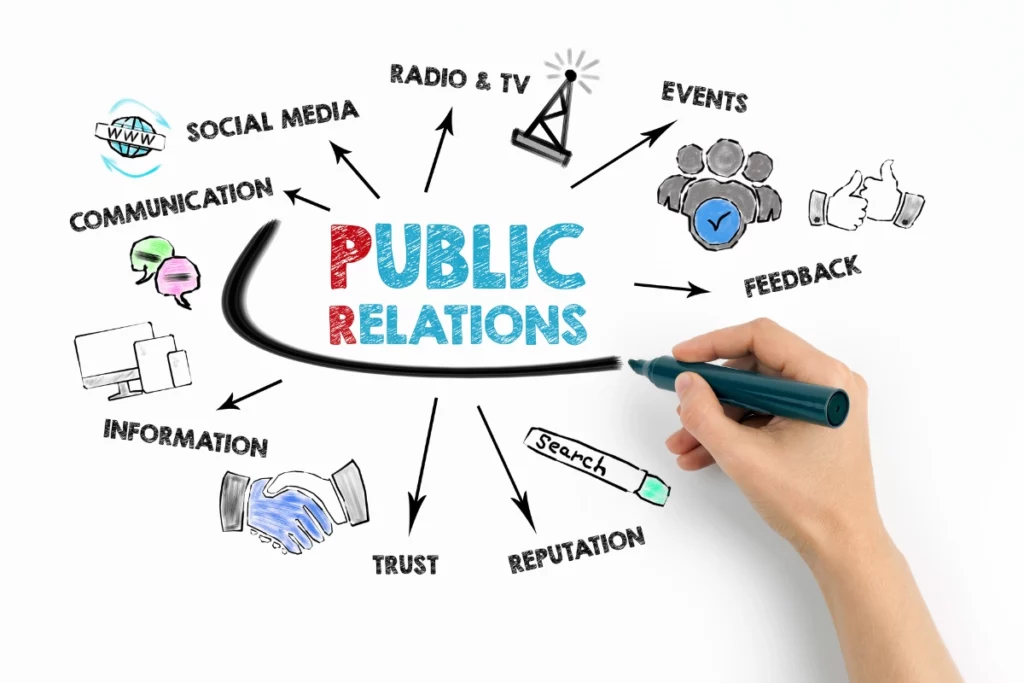
Public relations (PR) is the key to nurturing strong connections with businesses, and it is an essential component of effective marketing. Yet, as technology has changed over the years, so has public relations. The rise of Digital PR quickly made marketing professionals need to keep up with the latest online trends and strategies for success. To stay ahead of the curve, here are some Digital PR strategies to try in 2024.
What Does PR Mean?
PR, short for public relations, is the strategic process of communicating with one’s audience and stakeholders to shape the public perception of a business entity or personal brand. It encompasses how businesses or public figures engage with, build, and influence their communities.
Typically, the goal of PR is to create a positive public image and reputation for a business. Public relations also includes:
- Increasing awareness and recognition of a brand
- Researching and anticipating potentially impactful events for brand reputation
- Analyzing and assessing public perception of a brand and pivoting accordingly
- Working with marketing team members to ensure all efforts contribute to PR goals
- Mitigating crises that may negatively impact brand image
There are numerous strategies that public relations workers carry out to achieve the above goals. These tactics include writing press releases, collaborating with media outlets, creating social media posts, and much more.
In recent years, public relations has shifted from non-technological strategies to primarily digital ones. Currently, two important digital aspects of public relations are SEO and Social Media, which we will discuss more below.

SEO and Public Relations
Search Engine Optimization (SEO) is the process of optimizing your web pages and online platforms for search engines like Google and Bing. The goal of SEO is to have your digital platforms rank high in search engine results, displaying on the first results page. This helps drive traffic to your website, social media, and other online pages, overall boosting followers, conversions, and brand recognition.
In the digital age, SEO is now a part of PR. This is because SEO has the power to positively or negatively affect public image. For example, by ranking higher in search results pages (SERPs), businesses can present themselves as more authoritative players in their industries. Additionally, increased brand awareness through effective SEO also is important for building a stronger relationship with the public.
Social Media and Public Relations
Social media also now plays a major role in public relations. Social media platforms like Instagram, Facebook, and LinkedIn act as some of the main marketing outlets for brands. These platforms are also built to communicate messages with audiences, which is what PR is all about. Thus, PR professionals can utilize social media to influence public awareness and perception of brands.
Social media marketing is an excellent example of Digital PR. It is also a great demonstration of how digital PR brings numerous benefits that traditional PR never had. Let’s dive into the differences between digital vs. traditional PR, as well as the benefits of the modern age when it comes to building brand reputation.
Digital PR vs. Traditional PR
Both SEO and Social Media are examples of what is called Digital PR. Digital PR is a subset of public relations that only uses digital strategies to meet PR goals. Digital PR is closely related to digital marketing, using online platforms to communicate to audiences about your brand. Digital PR includes online strategies like social media posting, SEO, email marketing, influencer marketing, and blogging, to name a few.
Traditional PR refers to the traditional method of public relations that existed before modern technology. This includes offline strategies like print news and media, in-person press conferences, and radio and TV announcements. Though traditional PR methods are still important components, digital PR has taken precedence as a more modern approach.

Benefits of Digital PR
Digital PR brings many benefits over its traditional counterpart. Some of the main benefits of digital PR include:
- Increased reach – Digital PR allows for a widespread and global reach, with the potential to reach millions beyond geographical boundaries. Additionally, digital content is easily shareable, amplifying word-of-mouth reach.
- Ease of communication – Digital PR enables swift and direct communication with target audiences through various channels. This means that PR professionals can communicate with audiences anytime, anywhere.
- Enhanced insight and metrics – Digital PR provides access to detailed metrics and analytics, allowing PR professionals to track the performance of their campaigns in real time. PR leaders can also more easily assess audience reactions and views by reading posts, comments, and messages online.
- Deeper relationships – Through digital channels, PR professionals can engage with audiences on a more personal level. Brands can use interactive features like comments, shares, and direct messages to facilitate meaningful dialogue and relationship-building.
- Lower costs – Compared to traditional PR methods like print ads or TV commercials, digital PR campaigns often have lower costs. Digital platforms offer free or cost-effective avenues for content distribution, outreach, and engagement, making it accessible to businesses of all sizes.
- Greater ROI – The combination of increased reach, lower costs, and enhanced targeting capabilities in digital PR typically results in a higher return on investment (ROI) compared to traditional PR efforts. The ability to measure and analyze campaign performance allows for continuous optimization, maximizing the impact of PR initiatives.
Digital Public Relations Strategies to Use
With the game-changing benefits of digital PR in mind, PR professionals need to utilize online strategies to their fullest. Here are some of the top digital PR strategies that industry experts are using in 2024:
Guest Posting
Guest posting is an excellent digital public relations strategy to try this year. Guest posting entails contributing articles or blog posts to other websites or blogs within your industry or niche. Guest posting works by reaching out to other established brands and asking them to post on their platform(s) under your brand name. In these posts, brands can demonstrate their expertise and authority to a new audience in their industry. Brands may also be able to promote and link to their own platforms, driving traffic back to their own website.
This strategy is highly effective for digital PR as it allows brands to tap into existing audiences in their industry that are likely to connect with the brand. By collaborating with another reputable business, guest posts also establish credibility within your market. Moreover, guest posting helps build relationships with industry influencers and thought leaders, potentially leading to further collaboration opportunities and enhanced brand exposure.

Press Releases
Press releases remain a cornerstone of digital PR for their ability to disseminate newsworthy information to a wide audience. Issuing press releases online helps brands garner media attention, attract potential customers, and improve search engine visibility. This strategy is particularly beneficial for announcing product launches, company milestones, or industry insights.
A press release will look different depending on the digital platform you’re sharing it to. However, in digital PR, a press release often is in the form of an image or text. This image can be easily shared on any digital platform, from Instagram to LinkedIn to email. Depending on the subject, the press release may be in a more professional, black-and-white format, or it may be in a multi-media, colorful format.
Social Media
Utilizing social media is another key digital PR strategy in 2024. Social media PR lets brands engage directly with their audiences, spreading awareness no matter the time or location. PR professionals can use social media to:
- Establish a strong presence and following
- Humanize their image and foster meaningful connections with followers
- Address customer inquiries or concerns in real-time
- Distributing content that aligns with the brand image
- Running targeted advertising campaigns and viewing real-time metrics
- Monitoring brand sentiment in real-time
- Mitigate negative brand sentiment through posting or direct interactions (i.e. replying to comments)
Essentially, many of the traditional PR tactics can be done on social media, reaching wider audiences faster.
Influencer Marketing
Influencer marketing refers to partnering with social media influencers to promote a brand or product. This PR strategy has gained wide popularity in recent years. In fact, in 2023, 15% of brands spent over $500k toward influencer marketing, according to Influencer Marketing Hub. With the influencer marketing industry set to grow to $24 billion by the end of 2024, it’s time for PR professionals to get on this trend.
Similar to guest posting, partnering with influencers in your niche allows you to tap into a new audience within your market. This helps to build awareness and social proof. Plus, influencer marketing is unique in that influencers often have closer relationships with their followers. This means that audiences are more likely to trust the opinions of the influencers they follow, resulting in more meaningful awareness.

Backlink Building
Building backlinks is a crucial part of digital PR, where the goal is to get other respected websites to link back to your own. This isn’t just about boosting your site’s ranking in search results; it’s also about building trust and recognition for your brand. When reputable sites mention or link to yours, it shows that you’re a credible authority in your industry. This not only brings more visitors to your site but also improves your reputation online.
To build backlinks effectively, you need to actively reach out to other websites, foster relationships with them, and create content that’s valuable and worth sharing. When your content naturally attracts links from others, it boosts your credibility and visibility online. As a result, building a strong network of backlinks can have a significant impact on your brand’s online presence and overall PR efforts.
Expert Opinions and Research
Positioning company representatives or subject matter experts as thought leaders through expert opinions and research is an effective strategy for digital PR. By sharing valuable insights about their industry, brands can demonstrate their expertise and enhance credibility within their field. This may be done by contributing to industry publications, participating in podcasts or webinars, and conducting original research studies.
Additionally, sharing original research adds unique value to the conversation, distinguishing the brand from competitors. Through thought leadership content, brands can engage with their audience on a deeper level, sparking meaningful discussions and establishing themselves as trusted sources of information.

Press Conferences and Business Events
Hosting or participating in online press conferences, webinars, industry panels, or virtual events is another major PR strategy to try. These digital events provide valuable opportunities for brands to showcase their expertise, engage with their target audience, and generate media coverage. The digitization of press and business events also increases reach and accessibility, magnifying the potential positive effects on public perception.
Affiliate Programs
Affiliate programs are brand-hosted programs in which participants can promote brands and their products in exchange for a commission. Affiliate programs are a type of PR strategy that strategically increases the reach and recognition of your brand. By teaming up with affiliates who possess a dedicated following and authority within their field, brands can access their audience and capitalize on their credibility to endorse their products or services.
Plus, many affiliate programs have distinct guides on how to promote the brand, what content to share, and other rules that create a uniform marketing strategy. This helps to create a more cohesive brand image, which is essential for good PR.
Affiliate marketing also operates on a performance-based system, meaning brands compensate affiliates solely for successful sales or conversions they generate. This approach brings a favorable return on investment (ROI) and makes PR more affordable for businesses of any size.

What Makes Good PR Strategies?
Every business’s PR strategy may look different, but some overarching characteristics define a well-rounded PR strategy:
- Alignment with business objectives – Good PR strategies are aligned with the overarching goals of the organization. Whether it’s increasing brand awareness, driving sales, or managing reputation, PR efforts should be tailored to support the broader business agenda.
- Knowing your audience – Fully understanding the target audience is crucial for crafting PR strategies that resonate with the intended recipients. Thorough audience research and segmentation are necessary to tailor your brand messaging and ensure that it is well-received.
- Integrated approach – Successful PR strategies take an integrated approach, meaning there is consistency in brand messaging, voice, and image across all platforms and touch points.
- Regular evaluation and adjustment – A good PR strategy includes consistent measurement and evaluation to assess the effectiveness of your initiatives.
- Ethical and transparent practices – Ethical conduct and transparency are fundamental principles of good PR strategies. PR professionals should adhere to ethical standards and best practices to maintain trust in their industries.
In 2024, digital PR presents numerous opportunities for organizations to boost brand visibility, engage with audiences, and meet business goals. By employing the public relations strategies and tactics outlined above, you can be on track to building stronger, more meaningful relationships with your audience. Ready to leverage SEO and Digital PR for your business? Schedule a free strategy session with the experts at Sure Oak.





